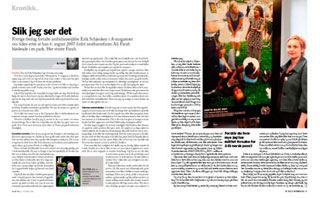(THIS ARTICLE IS MACHINE TRANSLATED by Google from Norwegian)
The reactions have been strong after Ny Tid last week printed a column by Ali Farah, the man who was beaten down in Sofienbergparken on 6 August 2007 and left behind by the ambulance staff. Ny Tid was this week reported to the police and complained to the Press' professional committee (PFU) for having put the text in print.
In addition, the reactions have been many and harsh. It does not surprise. This is the first time Farah himself has spoken in writing, and then as an answer to eight pages of editorial coverage in Aftenposten's A-magazine 3. October: Then one ambulance driver, Erik Schjenken, got his version of the case, some of the same allegations he made in a chronicle in the Aftenposten this spring.
In Ny Tid, we have over the past year chosen to cover this issue almost editorially. What we did now instead was to let go of Farah himself in the debate, since no other media had done so. The question is whether we should do it? Opinions are divided on this. A social anthropologist believed that New Age should "protect Farah from himself," which is an interesting statement.
The Secretary General of the Norwegian Press Association, Per Edgar Kokkvold, stated for his part to Klassekampen: «I understand what he has experienced. He must be allowed to express his rage, even if some of it is incoherent and unfair, so I think we should rise above it, and accept his mind… It is part of his obvious freedom of speech and some of this must we listen to. ”
So the next question is whether Ny Tid should have censored parts of the text, the parts that are not politically correct in today's Norway? In the midst of the media noise, it is worth noting that both SOS Racism and the Organization against Public Discrimination (OMOD) have given him full support:
"There is nothing I disagree with. There are unpleasant truths about racism in Norway and the world, which is hard to swallow for some ... Sometimes you need to hear such in big words .... It is a holistic chronicle, which must be read comprehensively from his situation. When he experiences what I feel is a reverse campaign in the press last week, where the victim has become the scapegoat because of a picture where he stands upright for two seconds, I realize he is responding, "Ola Melbye Pettersen of SOS Racism said to The class struggle.
At the same time, it is clear that Tid's editorial descriptions of colonial times and the present have a different angle and appearance than Farah's, like other debate posts we publish. New Time and Orientering has a 55-year tradition of being an open source for bold statements. And we will continue to do so, especially now that oppositional and unfamiliar opinions are under pressure in today's Norway. This summer, we were attacked by Gunhild Lem on Aftenposten's debate pages to let Muslim women into our columns. Recently, Ny Tid was refused an interview with the anonymous author Amal Aden. The Aschehoug editor used as a justification that we have "too good contacts in the immigrant communities".
It is interesting to note how the A-magazine's presentation, which eyewitnesses have described as untrue, seemed to open a flood of emotional sympathy for the ambulance drivers, including the one who has previously been part of the far-right Boot Boys. In the week leading up to Farah himself, there was hardly any media coverage in his favor.
It is also significant how the case after 3 October has become a media case, a critique of the press' use of the term racism. But first and foremost, this is a police matter. The special unit for police matters has issued fines against the two ambulance drivers. The fine of NOK 6000 has been imposed for "having committed misconduct during the performance of public service".
One driver, the one who appears, has refused to accept the fine, and on 24 November the case will be heard in Oslo District Court. The frequent media plays can probably also be understood in that context.
It is not difficult to predict which party will win in the Norwegian public. Until further notice, Ny Tid awaits the further legal process.


